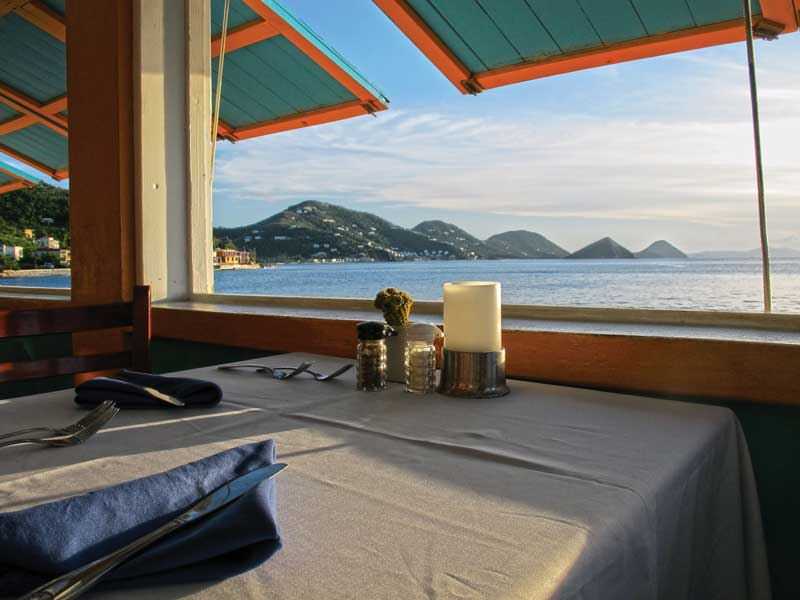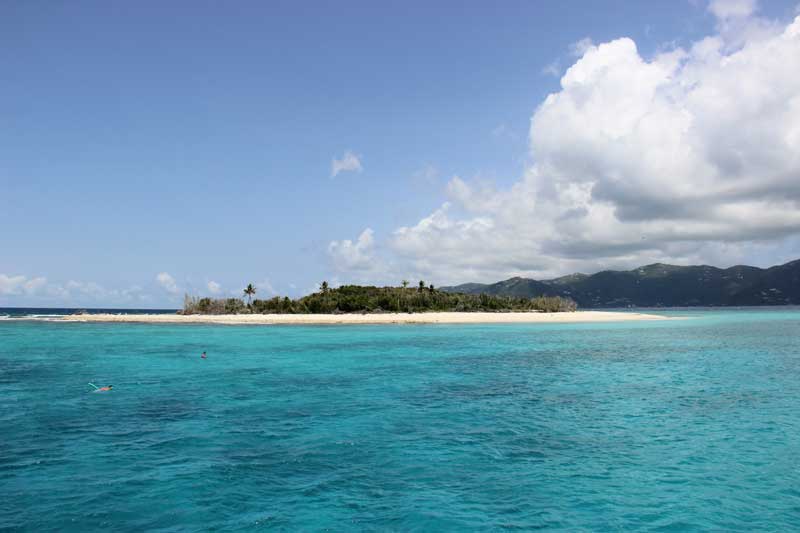A few years ago, not long after Hurricanes Irma and Maria tore through the Caribbean, I took my first bareboat powercat charter in the British Virgin Islands (BVI). While there were some special circumstances post-hurricane we had to deal with, there were a few other things we learned the hard way. Hopefully, I can help you from making some of the same mistakes.

1. Travel is exhausting.
For our trip, we had two flights with a layover, landed in St. Thomas, took a taxi to the ferry dock in Charlottle Amalie, St. Thomas, and then it was roughly an hour ferry ride to Road Town, Tortola. After going through customs, it was another taxi ride to the charter base. I’m exhausted just typing this.
By the end of our trip, we were all wishing we had budgeted in some down time between travel days. If you have the time/money, I would recommend spending one night in St. Thomas when you first arrive (or wherever you travel through, be it the USVI or Puerto Rico before arriving in the BVI), and at least one night (or more) to spend in either the BVI or USVI once the charter part of your trip is complete and before flying home.
2. You will go over budget.
When you arrive at your charter base, you will have to provision for the trip, unless you pre-paid to have the charter company provision the boat for you. You will also have to pay for fuel at the end of the trip, and while you can estimate this cost, you really won’t know the final amount until you pull into the gas dock. Apart from these bigger ticket items, there will be dinners out and beach bars to visit (those Painkillers add up quickly), along with mooring and marina fees, and if you decide on a whim to do some sort of tour or excursion on land, that will add up as well. Prepare for this ahead of time so that you’re not surprised when you see your credit card statement after the trip.

3. The art of provisioning is a tricky business indeed.
Experienced charterers will tell you that the goal should be to provision your boat so that you eat all of the food/drinks during your week at sea and pull back into the dock with little to no supplies left over. Over-provision, and you will either end up with wasted food or have to find someone to give it to. Under-provision and you could be in a different sort of pickle.
On my trip, we over-estimated our ability to buy meals out. It was vacation, after all, but what we didn’t take into account was that post-hurricane, many beach-side restaurants and bars were still closed. We had enough food for breakfast each morning, but we were constantly fighting over the one bag of chocolate chip cookies and after that trip, I couldn’t look at a frozen pizza for months. We figured the pizzas were small and easy to pop into the freezer, but after passing a few islands with only the remnants of beach bars still standing, those frozen pizzas were often our only option.
4. You can never have too much ice.
Unless you enjoy warm beer. We bought one tiny bag of ice at the charter base and then found it a little harder to come by after that. It was warm beers the whole trip.

5. Jellyfish…
I really have no good advice for this apart from, ‘don’t get stung.’ If you see jellyfish, like a lot of jellyfish, in a particular spot, maybe you should just go elsewhere. It’s not worth getting stung. One time, maybe, is okay, but when you get stung five times because you stayed in the same spot (me), it’s less about bad luck and more about stupidity.
We stayed because we were at the Baths on Virgin Gorda and amazingly had the lagoon practically all to ourselves. I should have gotten out of the water after the second sting, but I stayed in, so I have no one to blame but myself. Thankfully, my sweet grandmother packed a first aid kit and insisted I put it in my luggage. I laughed at the time, but I wasn’t laughing when that Benadryl came in handy. Other things to include in a first aid kit: band aids, gauze, antibacterial wipes, Tums, seasickness pills, pain relievers, and of course, your preferred allergy meds.
6. Don’t overpack.
When I spoke to other charterers prior to our trip, they all said to pack light. Some swimsuits, a pair of shorts, one dress, and that’s it. But did I listen? Of course not. I packed way too many sundresses and cute shore outfits when 99 percent of the time I was in my bathing suit and a cover up. The large suitcase I packed sat mocking me on the floor of my cabin, taking up precious space.

7. Bring a GoPro or other underwater camera.
You’ll be spending most of the time in the water anyway, so you’ll need a waterproof camera to capture all your adventures. I brought my large DSLR camera but rarely trusted taking it ashore in the dinghy so for most of the trip, I relied solely on my GoPro.
8. Have an open mind.
Sure, you could plan out your itinerary down to the minute based on what islands you will visit each day and where you will drop anchor or grab a mooring each night, but where’s the fun in that? There’s no harm in having a loose plan. In fact, I would recommend it, but be open to changing your plans based on where each day takes you.
There are more than 60 islands in the BVI, only about 15 of which are inhabited. Rather than plan where you will be each day, maybe pick a general direction, such as counterclockwise around the islands. That way if you plan to spend a whole day on Virgin Gorda but are run off by jellies, you have the flexibility to explore nearby islands you might otherwise have skipped. You will also need flexibility in case you can’t find an open slip or mooring ball at your spot of choice.
9. Take advice from the locals.
Everyone told us, ‘You have to visit Anegada Island.’ But we decided not to purely because it would be a long run out to the island, and we thought our time would be better spent elsewhere. To do this day, it’s one of my biggest regrets of the trip. Almost every person I’ve met since who has been to the BVI is shocked that we didn’t make it to Anegada. So, wherever you decide to charter, listen to the locals. If they tell you about a must-see spot, give it a try. Likewise, if they say to avoid a spot, perhaps because it’s overcrowded or overrated, heed their advice.
10. Have fun and be present.
A charter vacation is the perfect opportunity to unplug and really, truly relax. While many charter companies give you the option to pay for WiFi on the boat, you should ask yourself if you really need to check emails and Instagram on your vacation. They can wait. A week of cruising will go by in a flash if you don’t make a point to be present for every minute of it. So, unplug, leave the work worries at home, and enjoy this time with your family and/or friends. It’s been three years since my trip and to this day all I can think about is how badly I want to go back.
By Kaylie Jasinski